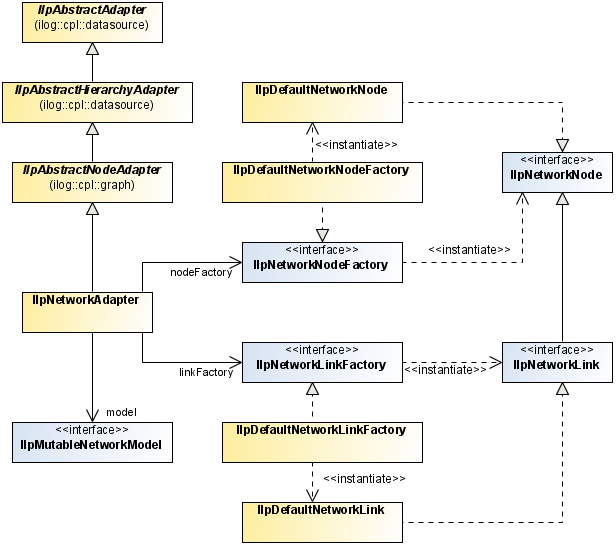The network adapter converts business objects into representation
objects of type network node and network link. It is defined by the
class IlpNetworkAdapter.
Network adapters retrieve structural information (that is,
parent/child relationship) about business objects from the
associated data source and determine whether an object should
appear as a root representation object by examining a list of
origins. See Setting a list of origins for details.
Like the tree adapter, the network adapter
supports load on demand.
The following figure shows network adapter
classes:

Network adapter classes
The network adapter creates either a node or a link representation
object depending on the value returned by the method getLinkInterface. If the return value is not
null, then a link is created; otherwise, a node is created.
Nodes are created with an IlpNetworkNodeFactory. By default, this
factory is an instance of the class IlpDefaultNetworkNodeFactory, which creates IlpDefaultNetworkNode instances.
Similarly, links are created with an IlpNetworkLinkFactory. By default, this
factory is an instance of the class IlpDefaultNetworkLinkFactory, which creates IlpDefaultNetworkLink instances.
The network adapter handles the position or shape of objects. By
default, it interprets every object attribute with the name
position
as denoting the position of the object. You can use the method setPositionAttribute in IlpAbstractNodeAdapter to specify any other
attribute to be used instead for all instances of a given IlpClass.
You can create a network adapter implicitly by instantiating the IlpNetwork component as shown in the
following example.
How to create a network adapter by instantiating a network component
IlpNetwork ilpNetwork = new IlpNetwork(); IlpDataSource dataSource = new IlpDefaultDataSource(); ilpNetwork.setDataSource(dataSource);
If you want to configure the adapter, to
set its origin for example, you must first retrieve it from the
network component and then set it to the data source.
How to configure a network adapter
IlpNetwork ilpNetwork = new IlpNetwork();
IlpDataSource dataSource = new IlpDefaultDataSource();
// configure the adapter, for example set an origin
IlpNetworkAdapter adapter = ilpNetwork.getAdapter();
adapter.setOrigins(Collections.singletonList("origin"),false);
adapter.setDataSource(dataSource);
For information on how to configure the adapter in CSS, see The Adapter rule.
Controlling the display of objects as containers
Unlike the tree adapter, the network adapter considers by default
that objects are not containers. There are two conditions for an
object to be a container: its getContainerInterface method should not
return
null
and the property
expansion
applying to that object should be set to
ExpansionType.IN_PLACE
. By default, this property is set to
ExpansionType.NO_EXPANSION
. For information on how to set a property value, see Introducing cascading style sheets.
Note
There is no way to represent an object in a network component as
a container, if its getContainerInterface returns
null
.
Creating a temporary representation object
The network adapter supports temporary representation objects.
These objects are placeholders that can be used in place of
permanent representation objects for editing purposes and, more
specifically, when new objects are created in the network view.
When a business object corresponding to the temporary
representation object is added to the data source, this temporary
representation object is removed and replaced by the permanent
representation of the business object. A filter, defined by IlpFilter, is used to determine when the
representation object of a business object added to the data
source is a candidate to replace the temporary representation
object. Filtering criteria can be of any kind.
The following example shows how to add a
temporary representation object to a network adapter.
How to add a temporary representation object to a network adapter
First you create the temporary
representation object, like this:
IlpDefaultNetworkNode temp=
new IlpDefaultNetworkNode(new IlpDefaultAttributeGroup());
Then you add it to the adapter along with the filtering
criteria using the method storeTemporaryRepresentationObject:
adapter.storeTemporaryRepresentationObject(temp, null, new IlpFilter() {
public boolean accept(Object o) {
IlpObject ilpO = (IlpObject)o;
return ilpO.getIdentifier().equals("right one");
}
};
The temporary representation object will
be replaced by a permanent representation object as soon as a
business object satisfying the filtering criteria is added to
the data source.